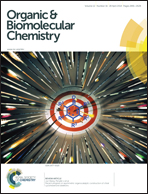Molecular binding behavior of a bispyridinium-containing bis(β-cyclodextrin) and its corresponding [2]rotaxane towards bile salts†
Abstract
Bispyridinium-bridged bis(β-cyclodextrin) (1) and its corresponding [2]rotaxane (2) were synthesized by a ‘click’ reaction, in which two different types of macrocycles, cucurbit[7]uril and β-cyclodextrin, are employed as the wheel component and bulky stopper, respectively. Moreover, the molecular binding behaviors of hosts 1 and 2 with four bile salts, namely, the sodium salts of cholic acid (CA), deoxycholic acid (DCA), glycocholic acid (GCA), and taurocholic acid (TCA), were comparatively investigated by 1H NMR spectroscopy and isothermal titration calorimetry experiments. The spectroscopic and microcalorimetric results can jointly demonstrate a cucurbituril-mediated binding process; that is, the introduction of cucurbit[7]uril has a pronounced impact on the electrostatic attraction and hydrogen-bonding interaction between the bispyridinium spacer in the host molecules and the hydrophilic terminal group in the guest molecules, ultimately giving a significant change in the thermodynamic origins of these supramolecular complexes.
![Graphical abstract: Molecular binding behavior of a bispyridinium-containing bis(β-cyclodextrin) and its corresponding [2]rotaxane towards bile salts](/en/Image/Get?imageInfo.ImageType=GA&imageInfo.ImageIdentifier.ManuscriptID=C3OB42103A&imageInfo.ImageIdentifier.Year=2014)

 Please wait while we load your content...
Please wait while we load your content...